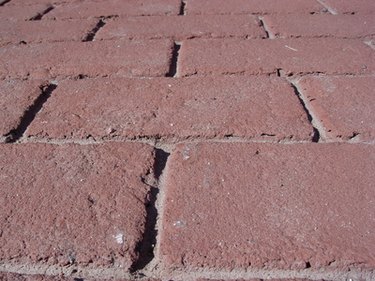Things You'll Need
3-inch screws
Construction adhesive
Backerboard
Thinset mortar
Grout
Notched trowel
Scrub brush
Concrete sealer

Brick flooring is often installed directly over a concrete slab, either outside or inside. However, with the right preparations, you can install brick flooring on top of a wooden subfloor. Although brick flooring installation on a wood subfloor will be slightly different than on a concrete floor, the outcome will be pleasing and long lasting. The average do-it-yourself homeowner can install brick flooring on his wood subfloors in one to two days, depending on the size and scope of the project.
Step 1
Ensure that the wood subfloor is well attached. If there is any loose wood, then reattach using 3-inch wood screws.
Video of the Day
Step 2
Install backerboard over the top of the subfloor. Backerboard is manufactured as either a concrete product or fiberboard product. The boards are purchased 1/4- to 1/2-inch thick and 3-by-5 feet. Install the board perpendicular to the wood subfloor boards and stagger the joints. Use construction adhesive beneath the backerboard, and drive 3-inch screws through the boards and into the floor joists. Use a stud finder to locate the floor joists.
Step 3
Spread thinset mortar onto the backerboard and lay your floor bricks. Use a notched trowel to distribute the thinset, and work only in a 4-by-4 foot area at a time. Thinset mortar must be used when installing your floor bricks over wooden subfloors because the floors flex, and thinset mortar has a latex additive that will allow for some flexibility.
Step 4
Install the brick flooring in your choice of patterns. The bricks are 1/2-inch thick, 8 inches long and 3 inches wide. You can choose to install the bricks in a running bond where the brick joints are staggered, in a stack bond where the bricks are stacked or in a basket weave where two bricks are horizontal and two are vertical.
Step 5
Allow the floor brick installation to dry for at least 24 hours before you walk on the surface. Any movement in the installation can cause the bricks to break loose from the mortar, which will require reinstallation.
Step 6
Grout the brick joints using a grout bag and latex-based grout, which will allow for expansion and contraction of the floor. This will prevent damage to the bricks once the grout and mortar have dried.
Step 7
Clean the floor bricks with washing powders and an acid brush. Limit the amount of water used to wash away the soap from the bricks, as the wood beneath the installation could become soaked and swell. Use a damp sponge to wipe away soap. After the floor has dried, seal the bricks with concrete sealer to prevent water from infiltrating the brick joints and damaging the wood subfloor.
Video of the Day